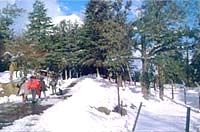 e were getting our breath back on the top of a hill facing the Vice Regal Lodge (now the Institute of Advanced Studies) in Shimla when we met Pandeyji.
e were getting our breath back on the top of a hill facing the Vice Regal Lodge (now the Institute of Advanced Studies) in Shimla when we met Pandeyji.
 An old man, wrinkled as only people in the mountains seem to get, he decided to share our bench. He was, he told me, a retired postman, and the kinds of things he knew about Shimla, he boasted, few others did.
An old man, wrinkled as only people in the mountains seem to get, he decided to share our bench. He was, he told me, a retired postman, and the kinds of things he knew about Shimla, he boasted, few others did.
Having told me about himself, he decided to figure out exactly who we were. I decided to test his knowledge by indulging in my favourite pastime on the hills -- trying to identify faraway buildings on distant hills.
"The Vice Regal Lodge," he told me, "was made in such a way that even though it's on the top of a hill, it is not visible from anywhere!" I pointed to another cottage with a green roof below, on the same hill, and asked him whether he knew what it was.
"Oh, that used to be the old Punjab Court," he said. "It had a cavernous tunnel connecting it directly to the underground dungeons of the Vice Regal Lodge, and many freedom fighters, who were tried and found guilty here during the British rule, never saw the light of day again!" I shivered in spite of the summer sun, and he went on.
"Many famous Indians were tried here -- many say that Bhagat Singh and his associate were sentenced here, but what I know for sure is that this is where Nathuram Godse's trial took place!"
His stories piqued my curiosity, and I decided to take a look. The building was not unlike most hill cottages, but above its door was a sign proclaiming that it was built in 1908.
It was in use as the office of the road-building wing of the Army. I hoped to find some plaque on the history of the building, but was disappointed.
The more than helpful staff there confirmed that they too had heard that Godse's trial had taken place there. "Where's the tunnel?" I asked. They pointed at my feet -- "right under where you're standing! This corridor, we're told, stands directly above the tunnel that led to the jail!"
There was little else to see there apart from an ornate chair that belonged to the court. But I was left curious for more. "If the government had maintained this place, it would have been so interesting," one of them commented, "after all, what took place within its walls was history eye-witnessed by our grandparents!"
Next, I walked up to the Vice Regal Lodge to see its dungeons. "The dungeons," said the official guide, "are being repaired by the Survey of India. Tourists can only see the museum."
So into the museum I went, and stared at picture after boring picture of Mountbatten, Jinnah, Gandhi and Nehru arriving to sign the historic Shimla agreement there.
"Was Godse imprisoned in the dungeons here?" I asked when there was a lull in the guide's monologue. Many bored tourists stirred with interest. "I don't know anything about it!" he snapped. "The dungeons are not part of the guided tour!"
I returned dissatisfied from the Lodge. At its gates, I met Pandeyji again, and recounted my experiences. "So do you think Nathuram Godse was really tried here?" I asked finally.
"That's what locals believe, but no official confirms it. I've always wondered why," he mused.
"When I see stamps of foreign countries depicting their heritage, I always feel that in India, we have so much more history than other countries. What we don't have, however, is the vision to appreciate it!"







